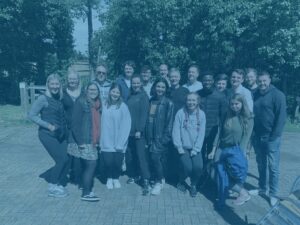
After a few months without a Think with Footprint (thank to extremely hectic schedules!) we were treated to the next instalment, from Essex University Lecturer, Dr Maged Ali.
Maged lectures in Digital Marketing at Essex Business School, and he’s been working in technology since 1994 – so he was the perfect fit for Footprint, getting us thinking about digital marketing and technology in a different way.
What is Culture?
Maged chose to speak to us about culture, and the relationship that it shares with technology. Firstly, he asked us what culture was. We had a lot of different answers for this, we thought culture could be something regional, something local, that it could be the practices and values you hold within a business, in fact we thought that culture could be pretty much anything that humans share. Everything we do is cultural!
There are many different theories pertaining to the definition of culture, for example, is culture all inclusive, or is it more focused on just a few things? Also, can we belong to more than one culture? We thought, definitely yes. We all belong to more than one culture or subculture – we have office culture, university culture, home culture, national culture, organisational cultures, group cultures. We are a mix of all of these different cultures in our own individual culture. (that’s a lot of cultures!)
Maged explained that many people think that there are two basic elements to any culture – its values and its practices. The practices of a culture are quite easy to change and evolve over time, but the values are much more entrenched (especially in national culture as we learn these in primary socialisation) and are therefore much harder to change.
Hofstede’s Workplace Cultural Dimensions
One sociologist who is often cited in articles related to culture, is Geert Hofstede. He looked at culture in the workplace, studying employees at IBM in 70 countries in the 60s and 70s. He discovered four cultural dimensions to begin with:
Power Distance; Individualism v Collectivism; Masculinity v Femininity; Uncertainty Avoidance
However, Maged explained that Hofstede’s depiction of culture was flawed. He didn’t look at the levels of culture when creating his cultural dimensions and didn’t account for culture changing over time. Also, Maged explained that culture is not homogenous, and that people in different areas of a country (or even the same area) can have different cultures, so the study was not generalisable to the general population. The cultural dimensions were also not comprehensive – later on, Hofstede had to add another two elements (long term orientation, and indulgence) so the first 4 weren’t enough.
Situated Culture
Instead of Hofstede’s approach, Maged suggested that we take a situated approach to culture, where instead of assuming there will be cultural differences between people, we just wait and see – assuming that there’s no difference and then letting the difference present itself if it is there, and then deciding if this difference is cultural or not whilst taking contextual factors into account. This approach allows culture to be more dynamic and fluid than a static approach which could see cultural differences where there aren’t any, or miss cultural differences.
Cultural Differences
What we did agree on is that culture is different for different people. To explain how important it is to understand cultural difference, Maged showed us a well-known HSBC advert – where an English business man visits Chinese clients, they take him to a restaurant and to be polite, he makes sure he finishes everything on his plate. Except, little does he know that this is causing offence to the Chinese, who think it is polite to leave a little food on the plate so that the host knows they are well fed.
Culture includes both implicit and explicit parts, we have high content cultures and low context cultures. In a high context culture, people are expected to know a lot of things implicitly – they are not spoken, whereas in a low context culture, most things are said explicitly. Problems can arise when a person from a low context culture joins a group from a high context culture, and things are not explained properly to them.
Does Culture Impact Technology?
In a word, yes. Culture impacts technology in many ways. In an obvious way, language differences make for different keyboards and ways of interacting with technology. Also, local and regional accents, which are inherently cultural, can impact a person’s ability to access the latest technology. We all remember the problems that Apple’s Siri had in understanding Scottish accents a few years ago! Consequently, the languages that we speak, and the way that we speak them both impact the development of technology, and the barriers that technology has to overcome to become useful.
Cultural (and societal) differences can also impact the access that people have to technology. For example, in the UK there is a huge divide between those who grew up with technology, and those who didn’t. The older generation are perhaps less likely to be ‘tech literate’ and less able to embrace new technology than the younger generation who have known no different. The culture of the younger generation is steeped in technology; thus, they have greater knowledge and therefore greater access to it.
Does Technology Impact Culture?
Again, absolutely. Whilst culture shapes and enables technology in some ways, so technology shapes and enables culture – especially through social media. Let’s take Instagram as an example. Whilst on the surface, this is simply a photo sharing platform where people upload images of their lives or inspirational quotes – everyone loves a good inspirational quote), if you look deeper, it is potentially a platform that is influencing the culture of those that use it. People use Instagram in several ways including:
As a search tool; For inspiration; To upload their own images.
As a search tool, Instagram influences culture because it helps people find places to go – for example, if you want to visit a restaurant, look it up on Instagram to find out what the food actually looks like. It broadens our travel horizons, when we book a holiday, we can use Instagram to search for what people are doing in the place that we’re visiting, and then we can make a list of the things we will do and the places we will visit.
For inspiration, people use Instagram to find out what’s fashionable – what the latest Influencers are wearing, where they’re going, what they’re eating and drinking. People can then emulate this in their everyday life, or at least dream of being able to emulate this lifestyle.
These two ways of using the platform clearly demonstrate that technology is influencing culture, because without Instagram, people wouldn’t easily know what influencers are wearing on a daily basis, or be able to search for restaurants in this way, so their real-life choices would likely change.
Technology & Hyperreality
The third use for Instagram is uploading images, and this is where technology really impacts culture. Images have always shown an edited version of history. We take pictures on happy occasions, to remember happy events, and they are usually posed. Images that look natural, often aren’t. Instagram takes this to another level. Some people take images purely for their Instagram feed, to create an ‘Instagram persona’ that does not reflect their real life, but to their followers it looks as though it does. These people create a false version of their lives through photo set ups and filters, and their followers believe this false lifestyle to be real. In this way, Instagram presents us with a postmodern hyperreality, where the audience is unable to distinguish this fake reality from actual reality. Fiction and nonfiction are indistinguishable, and this is potentially a problem created by the big impact that technology has on our culture.
Conclusion
Clearly, there is a strong relationship between culture and technology, they are both changing and adapting rapidly, and as they evolve, they become more and more intertwined. We wanted to thank Maged for giving up his time to come into the office and get us thinking, it was great for us to use our brains in a different way to the day-to-day!








